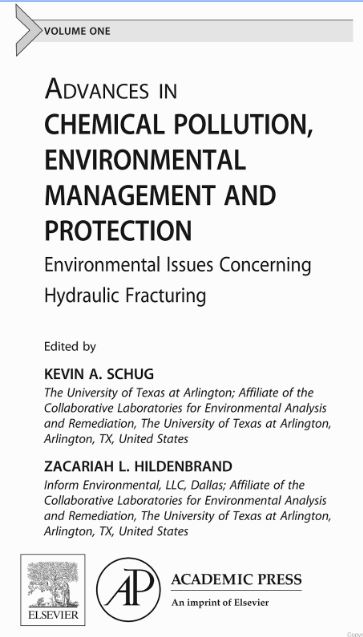Study: Harmful bacteria thrive in water contaminated near drilling by Mike Soraghan, November 22, 2017, E&E News
Texas researchers say they’ve found harmful bacteria in contaminated groundwater near Texas shale drilling sites, saying the discovery could explain some of the more unusual maladies claimed by neighbors of oil and gas production.
“It’s an ideal breeding ground for some of these more pathogenic bacteria,” said Zac Hildenbrand, one of the researchers on the study. In one area they investigated, he said, “people have been complaining of skin lesions. These bacteria cause skin lesions.”
Hildebrand cautioned that the research doesn’t prove a direct correlation between oil and gas operations and the bacteria. But he said the researchers are continuing to study the connection.
Hildenbrand leads a small consulting firm called Inform Environmental and is closely affiliated with a testing center at the University of Texas, Arlington, called the CLEAR Lab. CLEAR stands for Collaborative Laboratories for Environmental Analysis and Remediation.
Hildenbrand and his fellow researchers at the university published three studies on the oil-field bacteria in recent months. They were announced Tuesday by the school. They were published in two journals, Science of the Total Environment and Microorganisms.
The oil and gas industry contests many accusations of groundwater contamination.
But oil and gas regulators at the Texas Railroad Commission have reported they’re dealing with 577 cases of groundwater contamination from oil and gas operations, including 37 added in 2016 (Energywire, Aug. 1). The agency says none of those contamination cases resulted from the specific practice of hydraulic fracturing. [Oh, so if you are dressing, putting your underware on, but they’re not all the way up your legs yet and you tip over, it didn’t result from the specific practice of wearing underware?]
Two industry groups contacted about the study did not respond to requests for comment.
The key factor in the studies is a new method to detect bacteria in groundwater, looking well beyond what drinking water regulations require. The new method is called “matrix-assisted laser desorption/ionization time-of-flight mass spectrometry,” or MALDI-TOF.
The researchers found harmful bacteria can thrive in groundwater contaminated by natural gas constituents and chemical solvents. They also found the bacteria are particularly resistant to antibiotics and traditional forms of disinfection, such as chlorination.
Their third study identified two unique species of bacteria that could be used for bioremediation of contaminated groundwater. They demonstrated the potential to degrade toluene and chloroform. CLEAR does remediation, as does Inform Environmental.
Hildenbrand said the research raises the prospect that those who have complained of health problems at oil and gas sites were not sickened by drilling chemicals. Instead, their water could have been contaminated by bacteria that thrive in waters polluted by oil and gas operations. [Or, cumulative effects of being exposed to toxic chemicals and the harmful bacteria. ]
As the shale boom has intensified in recent years, people have complained about nausea, numbness, headaches and other symptoms. Cancer and birth defects have been linked in preliminary research to heavy drilling in an area.
Hildenbrand said when he researched groundwater contamination in Parker County, Texas, he frequently got a rash on his exposed legs just above his socks. Now he wonders if there’s a connection.
Hildenbrand has published several other studies pointing at groundwater contamination from oil and gas operations, drawing criticism from the industry. But the researcher said he has also been criticized by environmental groups for working with oil and gas companies, such as Apache Corp.
“I’m all for responsible shale development,” Hildenbrand said. “But we can’t fool ourselves and say no one has ever cut corners.”
[Hildenbrand’s been synergized too? Now he sounds like Canada’s frac enabler, Dr. John Cherry. There’s no such thing as “responsible shale development” except in fairy tale books written by industry lobby groups like Energy in Depth and Canadian Association of Petroleum Producers, and or fabricated in AER boardrooms with intent to rip social licence to frac, no matter how many aquifers are ruined, or how many families’ homes and lives are destroyed,from the reluctant public]
Team detects pathogenic bacteria in Texas groundwater near natural gas extraction sites by Phys.org, November 21, 2017
Three new research studies from the University of Texas at Arlington have found harmful pathogenic bacteria in Texas groundwater near unconventional natural gas extraction sites.
“Our latest published research has revealed that harmful bacteria can be quite prevalent in Texas groundwater, especially waters that contain various chemical contaminants” said Kevin Schug, Shimadzu Distinguished Professor of Analytical Chemistry and Director of UTA’s Collaborative Laboratories for Environmental Analysis and Remediation, or CLEAR, Lab.
“The next phase is to evaluate novel treatments against these dangerous pathogens and to develop safe strategies for the remediation of biologically-impaired sources of fresh water.”
Two of the studies, published in Science of the Total Environment, focused on characterizing microbial communities in the groundwater overlying the Barnett Shale and Eagle Ford Shale formations.
The studies, “Characterization of bacterial diversity in contaminated groundwater using matrix-assisted laser desoption/ionization time-of-flight mass spectrometry,” and “Exploring the links between groundwater quality and bacterial communities near oil and gas extraction sites,” indicate that pathogenic bacteria can thrive in contaminated conditions where natural gas constituents and chemical solvents are present, and that they are particularly resistant to antibiotics and traditional forms of disinfection such as chlorination. Pseudomonas aeruginosa and Aeromonas hydrophila were the most common, whereas the Bacillus cereus group was found to be immune to chlorination.
A third study, “MALDI-TOF MS for the identification of cultivable organic-degrading bacteria in contaminated groundwater near unconventional natural gas extraction sites,” published in the journal Microorganisms, identified two unique species of bacteria, Pseudomonas stutzeri and Acinetobacter haemolyticus, that could be exploited for the bioremediation of groundwaters that are contaminated with chemical solvents. The two bacteria showed a capacity to degrade toluene and chloroform, opening up the possibility that they can be potentially used in the bioremediation of spills.
The CLEAR Lab also recently produced a new textbook with international multimedia publishing group Elsevier entitled, “Advances in Chemical Pollution, Environmental Management and Protection: Environmental Issues Concerning Hydraulic Fracturing,” which covers a broad range of topics pertaining to the environmental, societal, economical and human health implications of unconventional oil and gas development.
“Collectively, the methods that we’ve developed through these new studies allow us to quantify more than 2,500 different bacterial species simultaneously in any given sample. This, coupled with some of the best management practices that we’ve outlined in our new textbook, will allow us to contribute to improving the environmental stewardship of unconventional oil and gas development, particularly with respect to the recycling of produced wastes,” said Zacariah Hildenbrand, Chief Scientific Officer at Inform Environmental LLC and major contributor to CLEAR.
Explore further: Study finds abnormalities in drinking water in Eagle Ford Shale region
***


Environmental Issues Concerning Hydraulic Fracturing, Volume 1
1st Edition
Serial Volume Editors: Kevin Schug Zac Hildenbrand
eBook ISBN: 9780128128039
Paperback ISBN: 9780128128022
Imprint: Academic Press
Published Date: 30th October 2017
Page Count: 424
1. Hydraulic Fracturing: The Technology Explained
George E. King and Danny Durham
2. Unconventional Oil and Gas Production: Waste Management and the Water Cycle
Tiffany Liden, Billy G. Clark, Zacariah L. Hildenbrand and Kevin A. Schug
3. Chemicals in Drilling, Stimulation, and Production
George E. King and Danny Durham
4. Hydraulic Fracturing Chemical Disclosure: Can the Public Know What’s Going Into Oil and Natural Gas Wells?
Dusty Horwitt
5. The Human Health Implications of Oil and Natural Gas Development
Anne C. Epstein
6. Public Health Concerns and Unconventional Oil and Gas Development
Paula Stigler Granados
7. Societal Implications of Unconventional Oil and Gas Development
Sabrina Habib, Melanie S. Hinojosa and Ramon Hinojosa
8. Analytical Approaches for High-Resolution Environmental Investigations of Unconventional Oil and Gas Exploration
Doug D. Carlton, Jr., Zacariah L. Hildenbrand and Kevin A. Schug
9. Considerations and Pitfalls in the Spatial Analysis of Water Quality Data and Its Association With Hydraulic Fracturing
Jesse M. Meik and A. Michelle Lawing
10. Hydrocarbon Emissions: Anthropogenic and Natural Sources
George E. King and Danny Durham
11. Henry’s Law and Monitoring Methane in Groundwater Wells
Bryce Payne
12. The Characterization of BTEX in Variable Soil Compositions Near Unconventional Oil and Gas Development
Emmanuel Varona-Torres, Doug D. Carlton, Jr., Bryce Payne, Zacariah L. Hildenbrand and Kevin A. Schug
13. Mass Spectrometry for the Study of Microbial Communities in Environmental Waters
Inês C. Santos, Zacariah L. Hildenbrand and Kevin A. Schug
14. Best Management Practices From the “Responsible Shale Energy Extraction” Conference: Guiding Industry in Environmental Stewardship
Alison Paige Wicker, Zacariah L. Hildenbrand and Kevin A. Schug
Environmental Issues Concerning Hydraulic Fracturing, Volume One captures the state-of-the-art research currently used to evaluate the potential impact of unconventional gas and oil gas extraction processes. Topics in this comprehensive guide on the topic include chapters on The Human Health Implications of Unconventional Oil and Gas Development, The use of Noble Gas Analysis and other Forensic Techniques in Characterizing Contamination Pathways Associated with Oil and Gas Development, Well Integrity, Contamination Mechanisms and Groundwater Impacts Associated with Unconventional Oil and Gas Development, and Advances in Fracturing and Well Construction: Improving Efficiency and Reducing Risks.
This serial explores a wide breadth of emerging and state-of-the-art technologies used to study the potential environmental impact and various processes in the massive industrial process of shale exploration and resource extraction.
- Covers a wide breadth of emerging and state-of-the-art technologies
- Includes contributions from an International board of authors
- Provides a comprehensive set of reviews, covering the potential impact of unconventional gas and oil gas extraction processes
From concerned and informed citizens to scientists in the environmental and energy sectors
[Refer also to:


2016 01 05: Yet another study: Fracking plays active role in generating toxic metal wastewater
2016 02 10: Alberta & Texas: Drilling records suggest lax enforcement of oil and gas industry
